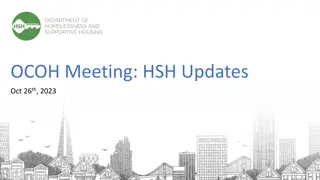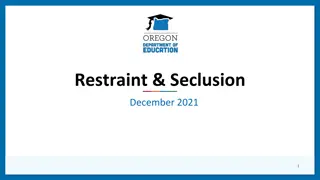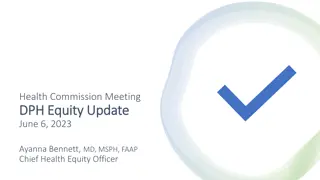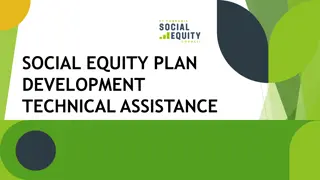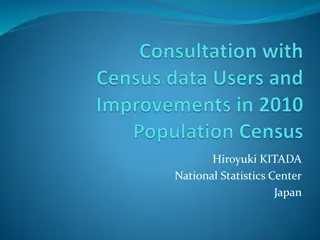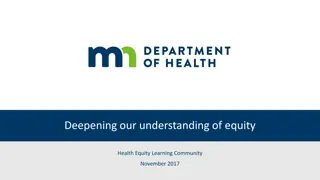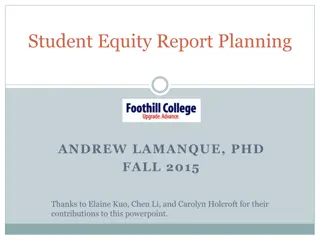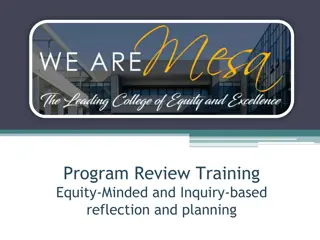Enhancing Equity Through Annual Unit Planning Innovations
Explore the latest updates in Annual Unit Planning for 2023-24, including enhanced data integration, increased access to disproportionate impact data, and streamlined processes. Discover how these changes support equity goals and empower units to make informed decisions for a more inclusive future.
Download Presentation

Please find below an Image/Link to download the presentation.
The content on the website is provided AS IS for your information and personal use only. It may not be sold, licensed, or shared on other websites without obtaining consent from the author.If you encounter any issues during the download, it is possible that the publisher has removed the file from their server.
You are allowed to download the files provided on this website for personal or commercial use, subject to the condition that they are used lawfully. All files are the property of their respective owners.
The content on the website is provided AS IS for your information and personal use only. It may not be sold, licensed, or shared on other websites without obtaining consent from the author.
E N D
Presentation Transcript
Welcome! Annual Unit Planning 2023-24: What s New, Why We Do It, & How to Get It Done Brian Knirk (he/him), Hospitality Management Veronica Lopez (she/her), Nutrition Yuj Shimizu (he/him), Psychology, Faculty Research Coordinator
Land Acknowledgement We acknowledge the land which we occupy at American River College as the traditional home of the Nisenan, Maidu, and Miwok tribal nations. These sovereign people have been the caretakers of this land since time immemorial. Despite centuries of genocide and occupation the Nisenan, Maidu, and Miwok continue as vibrant and resilient tribes and bands, both Federally recognized and unrecognized. We take this opportunity to acknowledge the generations that have gone before as well as the present-day Nisenan, Maidu, and Miwok people.
Agenda 1. What s new with Annual Unit Planning (AUP) and data in the Integrated Planning Portal (IPP) 2. Why we do AUP and how it can help us reach our Equity goals 3. How do you get AUP done in your unit
Whats New? The Standard Data Set for Annual Unit Planning has been updated! Better Integration with ARC Data on Demand (Precision Campus) Direct links, with additional disaggregation and filtering options Greater emphasis and access to disproportionate impact data More student attributes (Gender, Race/Ethnicity, Veterans, Foster Youth, Disability, Poverty Level Status) with Intersectionality According to the California Community Colleges Chancellor s Office, disproportionate impact occurs when a subset of students, based on a student characteristic such as age, race, or gender have observably different outcomes Removed Productivity Data Element to streamline process Removed color codes (except for DSS) to simplify interface
Why Change? Integration with ARC Data on Demand provides units with more sophisticated and nuanced ways of exploring their data E.g. enables increased awareness of enrollment trends by course attributes (e.g. modality) and student attributes (e.g. age, gender, race) Greater emphasis and access to DI data enables more student-centered and equity-centered analysis, reflection, and planning E.g. enables increased awareness of which students are disproportionately impacted E.g. enables increased awareness of intersectional DI Together, these changes should help to better promote equity and inform departmental dialogue, planning, decision making and resource allocation
Data Resources ARC Data on Demand (Precision Campus) Yuj Shimizu, Faculty Research Coordinator, shimizy@arc.losrios.edu Drop-in hours for help with Data on Demand or Standard Data Set (TBD) Jeff Sacha, Center for Teaching and Learning Faculty Book a 50-minute Collaborate for Change appointment via zoom on Fridays between 11 AM and 1 PM, or by appointment Book using the calendly link in the chat or find the link on the CTL website Individual or group appointments available Email Jeff at sachaj@arc.losrios.edu with questions
Part 2: How can it help us reach our Equity goals and Why do we do AUP?
Whats our context? We center students, we center equity Academic Senate resolutions Each department will build on their strengths in their equitable approach
Address DI and Achieve Educational Equity Close equity gaps in student success in courses in your department/program Improve teaching and learning in your classrooms and department/program Achieve equity in access to your programs
How do equitable approaches inform your AUP? For example, ways your plans will address DI: (Add examples) Identify DI data to address How you resource Who you are including Support you are asking for Adapted from ARC Institutional Equity Plan
What does Annual Unit Planning accomplish Encourage communication and planning for continuous improvement Engage in data-based inquiry to inform goals and actions Close our College s equity gaps Communicate resource needs and link resources to goals Institutional accountability Meet accreditation requirements (set goals and hold ourselves accountable to them)
Annual Unit Planning & Time Frame is NOW You are planning for the current 2023-2024 year The data you are being provided is fresh - this is Fall 22-Spring 23 data You want to implement what you can immediately Not everything requires financial resources, much of what we may want to improve can be done immediately You also want to build on your work from previous years plans This is why we are encouraging you to begin the conversations with your departments ASAP (August meetings if you can) (We recognize not every department can do this)
Program Review/Unit Planning Cycle Program Review (every 7 years): Assesses the program and uses the findings to inform future plans Creates measurable objectives (strategic enhancement) Aligns objectives to the ARC commitment to social justice and equity (ongoing commitment) Annual Unit Plan (every year): Reviews data and creates action steps and related resource requests based on program review objectives Aligns action steps and resource needs to ARC strategic goals (specific to the year) Next Program Review: Measures progress towards objectives by considering whether the action steps had the intended effect
Part 3: How do you get AUP done in your unit?
2023 - 2024 Annual Unit Planning Timeline Dates Role Action August / September Authors Look At The Data With Your Department Friday September 8th 9-11 Repeat Training (Encourage Other Faculty to Participate) September / October Authors Working With Your Department, Develop Objectives and Strategies to Improve Your Data Friday October 27 Authors Write and Turn in Your Plan November 17 Reviewers Review & Approve Senior Administrators December 1 Review & Approve
Steps for Annual Unit Planning 1. Review and Update the status of actions from your unit's previous Annual Unit Plan. 2. Review your unit's standard data set and additional data with your department. 3. Support ARC's strategic planning goals and address data issues by adding new planning objectives and action steps. 4. Review your unit's Planning Objective Summary with your department. 5. For any of your unit's Planning Objectives that require resources, identify needed resources. 1. Submit Annual Unit Plan by October 27th.
Encourage conversations focused on continuous improvement and potential actions within your control. Ask yourselves: What actions can our department take to increase enrollment? What barriers exist for our DI students (perhaps be specific to the populations) that we have the opportunity to help minimize or eliminate? What are we doing to build on on students strengths? What do our Department Set Standards tell us about our success and how are they informed by the other data? Are our students meeting our SLO s and how can we better help them to master the course and department SLO s
Examples of Action Titles & Descriptions Action 1: Gain Knowledge - DI Gain knowledge on how to best serve disproportionately impacted individuals by attending conferences, Flex Events, seminars, read books, and/or cross-train with fellow faculty. Action 1: Advisory Day Develop orientation for students in the form of an "Advisory Day", and mandatory advising sessions with students throughout the semester to ensure the students success with their chosen pathway. A database to be created to support the process. Modeled after the Success Event held by the Music Dept. Action 1: Connecting Students to available services Faculty will proactively utilize campus programs and services, including the newly developed Starfish and Homebase programs to assist disproportionately impacted students who are struggling in courses.
Examples of Action Titles & Descriptions Action 1: Revise the curriculum of our courses. Our department's composition committee will revise our composition sequence curriculum with an equity lens in order to reduce and, ultimately, eliminate the disproportionate impact in success and mastery in our writing courses. Action 1: Increase open lab access Students of disproportionately impacted groups in impacted courses may benefit from additional lab access. Faculty intend to increase to open lab by optimizing scheduling for the existing courses. Action 1: Helping Students Build Self-Efficacy Pair students up in workshops. Ensuring that DI students are represented with the general population by proactively recruiting students for the workshops. Action 1: Mandatory Office Hours The faculty will require students to meet on a mandatory basis at least twice per semester for performance reviews and progress in their courses. Due to the amount of courses on rotation, faculty will give students insight to their pathway will assist students in preparation for their next semester of courses.
Consider Your Goals and Your Place in the Program Review Cycle Instead of making twenty objectives and carrying them over year after year, consider how you plan to progress over seven years towards a specific goal. Think small, measurable, change. This kind of change will also be easier to keep track of and fund.
Break Out Groups Log into your AUP: https://ipp.arc.losrios.edu/ Explore Your Data (10 Minutes) Discuss: What did you learn? What types of strategies might you use to help your DI students? What does that look like in your classroom | department | AUP ?
Dont forget! This is a group project. 1. Share the Annual Unit Plan data with your department and discuss it as a group and brainstorm action to take. 2. Share your Objective Action Summary with your department before you submit your Annual Unit Plan.
But we cant possibly meet that deadline Just let us know. The intent of the earlier deadline is to encourage conversation and planning. Remember the idea is to implement immediately - what can we do now?
AUP and Portal Help For Annual Unit Planning support: Brian Knirk, Program Review Chair, knirkb@arc.losrios.edu We can zoom or chat on the phone as well. For help with data: Yuj Shimizu, Faculty Research Coordinator, shimizy@arc.losrios.edu Jeff Sacha, Center for Teaching and Learning Faculty, sachaj@arc.losrios.edu For Technical Support: Mary Goodall, goodalm@arc.losrios.edu, 916-484-4535





